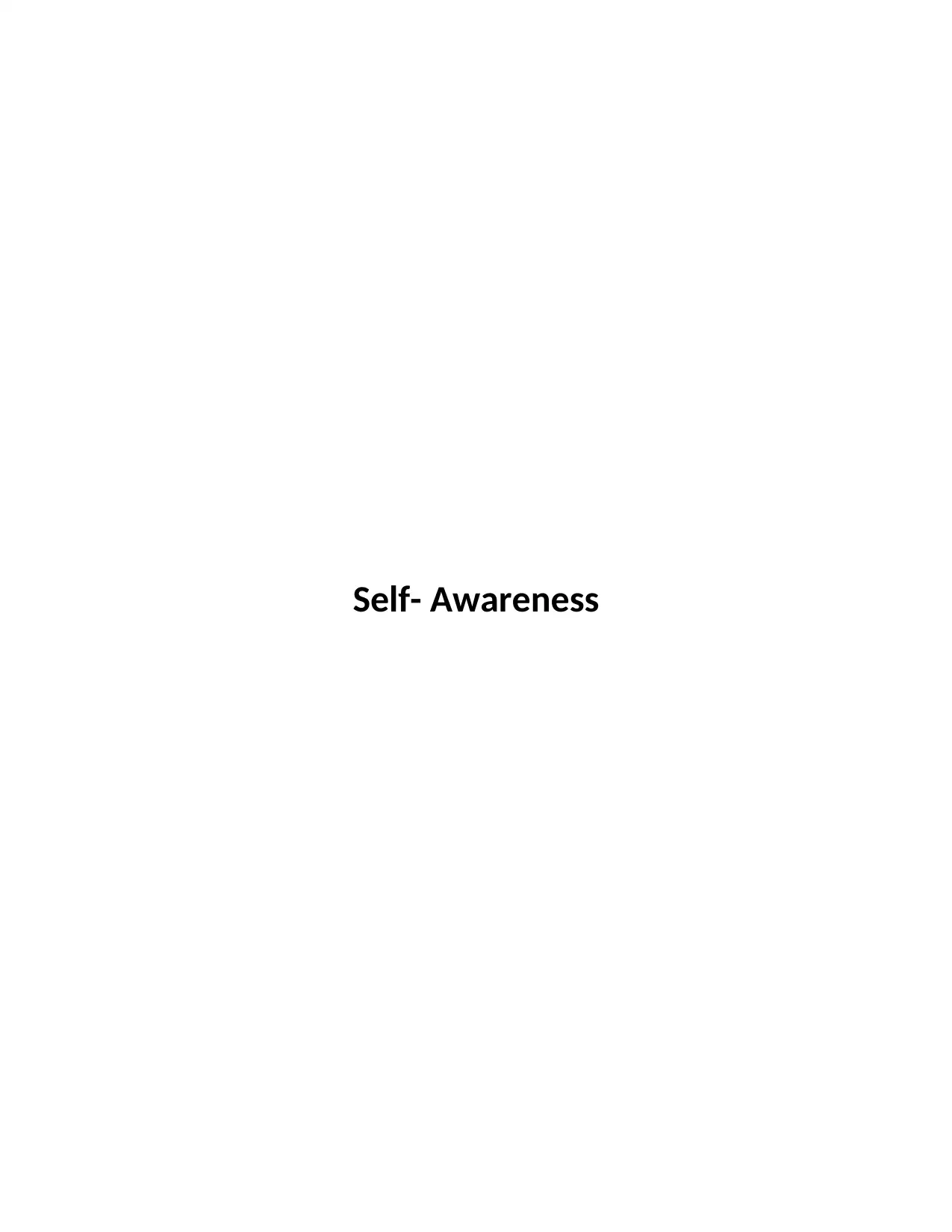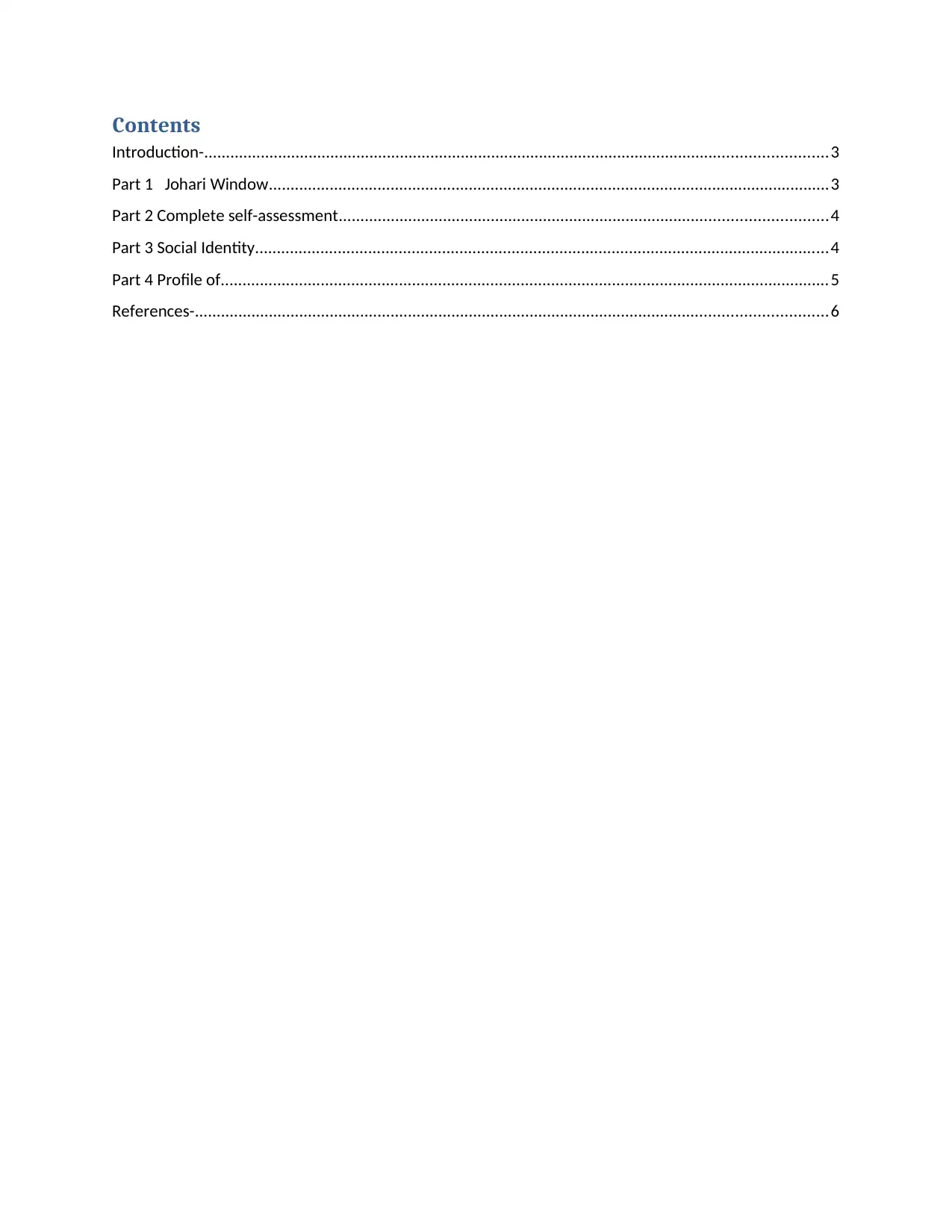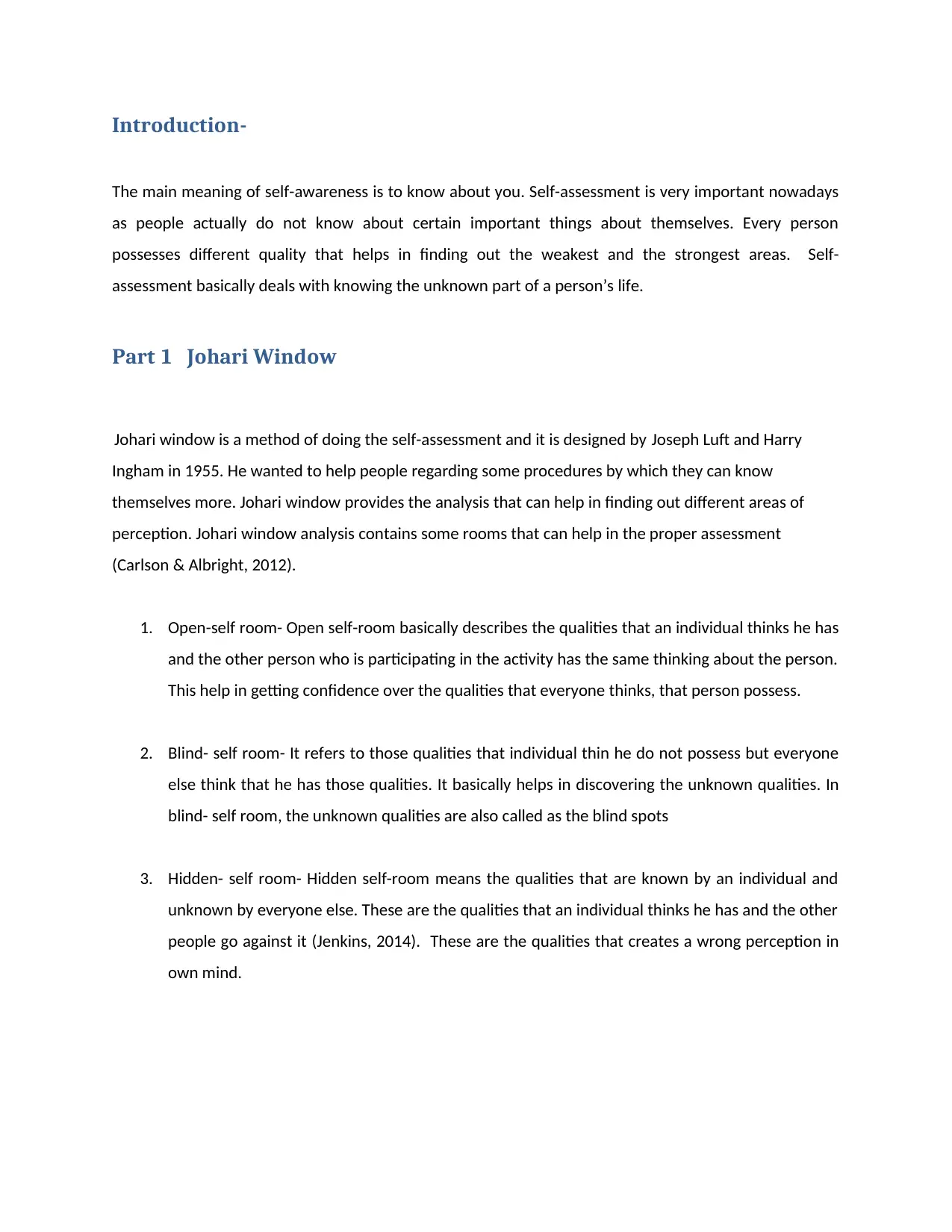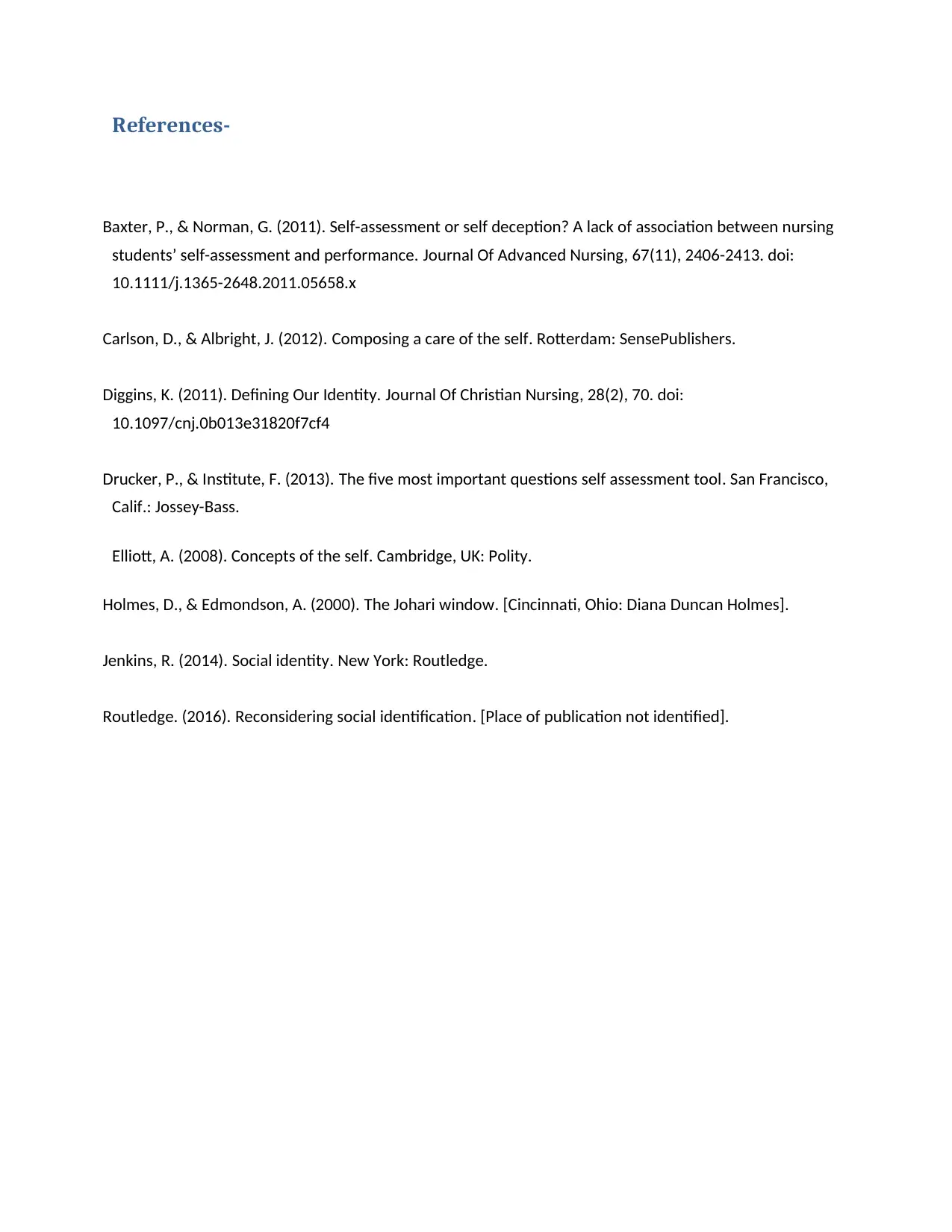Exploring Self-Awareness, Social Identity, and Self-Assessment
VerifiedAdded on 2023/06/10
|6
|1315
|383
Homework Assignment
AI Summary
This assignment is a self-assessment exercise, exploring the concept of self-awareness through the Johari Window, a tool designed to analyze different aspects of perception, including open, blind, and hidden selves. The assignment then moves on to a complete self-assessment, emphasizing the importance of understanding personal perceptions and structuring the world to gain insights. It further delves into the student's social identity, specifically focusing on their Buddhist faith and how it shapes their beliefs, practices, and interactions with others. The student discusses how Buddhism influences their values, practices such as mantra chanting and meditation, and how these aspects contribute to their self-understanding. The assignment concludes with a profile of self, reflecting on the insights gained from the self-assessment, identifying positive and negative qualities, and discussing how their social group influences their self-perception. The student reflects on how the process of self-assessment has provided valuable insights into their personality and how it can be used for personal growth and development.

Self- Awareness
Paraphrase This Document
Need a fresh take? Get an instant paraphrase of this document with our AI Paraphraser

Contents
Introduction-...............................................................................................................................................3
Part 1 Johari Window.................................................................................................................................3
Part 2 Complete self-assessment................................................................................................................4
Part 3 Social Identity....................................................................................................................................4
Part 4 Profile of............................................................................................................................................5
References-.................................................................................................................................................6
Introduction-...............................................................................................................................................3
Part 1 Johari Window.................................................................................................................................3
Part 2 Complete self-assessment................................................................................................................4
Part 3 Social Identity....................................................................................................................................4
Part 4 Profile of............................................................................................................................................5
References-.................................................................................................................................................6

Introduction-
The main meaning of self-awareness is to know about you. Self-assessment is very important nowadays
as people actually do not know about certain important things about themselves. Every person
possesses different quality that helps in finding out the weakest and the strongest areas. Self-
assessment basically deals with knowing the unknown part of a person’s life.
Part 1 Johari Window
Johari window is a method of doing the self-assessment and it is designed by Joseph Luft and Harry
Ingham in 1955. He wanted to help people regarding some procedures by which they can know
themselves more. Johari window provides the analysis that can help in finding out different areas of
perception. Johari window analysis contains some rooms that can help in the proper assessment
(Carlson & Albright, 2012).
1. Open-self room- Open self-room basically describes the qualities that an individual thinks he has
and the other person who is participating in the activity has the same thinking about the person.
This help in getting confidence over the qualities that everyone thinks, that person possess.
2. Blind- self room- It refers to those qualities that individual thin he do not possess but everyone
else think that he has those qualities. It basically helps in discovering the unknown qualities. In
blind- self room, the unknown qualities are also called as the blind spots
3. Hidden- self room- Hidden self-room means the qualities that are known by an individual and
unknown by everyone else. These are the qualities that an individual thinks he has and the other
people go against it (Jenkins, 2014). These are the qualities that creates a wrong perception in
own mind.
The main meaning of self-awareness is to know about you. Self-assessment is very important nowadays
as people actually do not know about certain important things about themselves. Every person
possesses different quality that helps in finding out the weakest and the strongest areas. Self-
assessment basically deals with knowing the unknown part of a person’s life.
Part 1 Johari Window
Johari window is a method of doing the self-assessment and it is designed by Joseph Luft and Harry
Ingham in 1955. He wanted to help people regarding some procedures by which they can know
themselves more. Johari window provides the analysis that can help in finding out different areas of
perception. Johari window analysis contains some rooms that can help in the proper assessment
(Carlson & Albright, 2012).
1. Open-self room- Open self-room basically describes the qualities that an individual thinks he has
and the other person who is participating in the activity has the same thinking about the person.
This help in getting confidence over the qualities that everyone thinks, that person possess.
2. Blind- self room- It refers to those qualities that individual thin he do not possess but everyone
else think that he has those qualities. It basically helps in discovering the unknown qualities. In
blind- self room, the unknown qualities are also called as the blind spots
3. Hidden- self room- Hidden self-room means the qualities that are known by an individual and
unknown by everyone else. These are the qualities that an individual thinks he has and the other
people go against it (Jenkins, 2014). These are the qualities that creates a wrong perception in
own mind.
⊘ This is a preview!⊘
Do you want full access?
Subscribe today to unlock all pages.

Trusted by 1+ million students worldwide

Part 2 Complete self-assessment
Everyone cannot have the capability to sense everything in an effective an efficient way. There
are so many things that take place around and we do not able to assess the same. Self-
assessment is a tool that helps in sorting such problems and makes you know a lot about
yourself. There is a personal need of every individual to structure the world accordingly by
doing self- assessment. It helps in the betterment of an individual. People create several
perceptions according to the blind- room and it is not the correct way. This helps in creating a
different image of an individual (Reconsidering social identification, 2016). An individual wants to
structure the world in a way so that he can come to know about several perceptions, people
has created for him. An individual can apply some positive changed according to the
perceptions and can try to convert the negative perception into the positive one. Perceptual
structure is a good thing that I can use to create changes and adopt some good qualities for
getting myself as a better person.
Part 3 Social Identity
Every person belongs to a social group as he lives in a society that consists of human beings. Social
groups can be formed as per different characteristics like religion, caste and gender. I belong to a
Buddhism group as I Have a blind faith on Buddhism. I really think that chanting of mantra can bring
changes to my life. I am a Buddhism follower that’s why I used to wear a locket of a sign belong to
Buddhism. Buddhism describes that it is important for every person to know himself in a complete way
so that he can work upon the imperfections (Elliott, 2008). Buddhism believes in Rebirth and Karma. I
always do the right things that are right according to me and according to other people as well. I used to
chant my mantras whenever I feel insecure, alone and depressed. These mantras give me a different
kind of energy. People can differentiate me by this feature. I used to think about the well- being of other
people as Buddhism believes in providing care to others without selfishness (Diggins, 2011). There are
different methods that have been created by Buddhism to work upon the mind and meditation is one of
Everyone cannot have the capability to sense everything in an effective an efficient way. There
are so many things that take place around and we do not able to assess the same. Self-
assessment is a tool that helps in sorting such problems and makes you know a lot about
yourself. There is a personal need of every individual to structure the world accordingly by
doing self- assessment. It helps in the betterment of an individual. People create several
perceptions according to the blind- room and it is not the correct way. This helps in creating a
different image of an individual (Reconsidering social identification, 2016). An individual wants to
structure the world in a way so that he can come to know about several perceptions, people
has created for him. An individual can apply some positive changed according to the
perceptions and can try to convert the negative perception into the positive one. Perceptual
structure is a good thing that I can use to create changes and adopt some good qualities for
getting myself as a better person.
Part 3 Social Identity
Every person belongs to a social group as he lives in a society that consists of human beings. Social
groups can be formed as per different characteristics like religion, caste and gender. I belong to a
Buddhism group as I Have a blind faith on Buddhism. I really think that chanting of mantra can bring
changes to my life. I am a Buddhism follower that’s why I used to wear a locket of a sign belong to
Buddhism. Buddhism describes that it is important for every person to know himself in a complete way
so that he can work upon the imperfections (Elliott, 2008). Buddhism believes in Rebirth and Karma. I
always do the right things that are right according to me and according to other people as well. I used to
chant my mantras whenever I feel insecure, alone and depressed. These mantras give me a different
kind of energy. People can differentiate me by this feature. I used to think about the well- being of other
people as Buddhism believes in providing care to others without selfishness (Diggins, 2011). There are
different methods that have been created by Buddhism to work upon the mind and meditation is one of
Paraphrase This Document
Need a fresh take? Get an instant paraphrase of this document with our AI Paraphraser

them. I use to meditate on daily basis to create peace of mind and then work upon the self (Drucker &
Institute, 2013).
Part 4 Profile of
Self- assessment has showed me a different person that I have never came across. It helped me to find
out the areas, I was unaware of. It helped me know the positive as well as negative qualities that I
possess. It also defined the perception of people regarding me. It can help me a lot for my future growth
and welfare (Baxter & Norman, 2011). Now I know the blind spots that can provide an advantage to me.
There are different qualities that are creating wrong perception about me because I apply the same on
wrong places. People think that I am a very selfish person and I think this is not right because it is a very
common human nature that a person has to think about himself before thinking about the others. I use
to follow Buddhism and I always get time out of my busy schedule for chanting and meditation that
makes people think wrong about me. So these are the things that need to be clear. I always believe in
Karma and try to do right things only. I never want to hurt anyone as I have to pay back for this. I also
know about the qualities that I do not possess but people think that I have those qualities. Everyone
thinks that I am a very positive person but I think when I feel nervous that too much of negativity comes
in my mind. I analyzed that somewhere my known or unknown qualities came from the social group to
whom I belong because I apply all the learnings I get from this group in my daily life. Self-assessment has
proved very helpful for me as it can bring many positive things in my life and now I know myself as a
whole completely (Holmes & Edmondson, 2000).
Institute, 2013).
Part 4 Profile of
Self- assessment has showed me a different person that I have never came across. It helped me to find
out the areas, I was unaware of. It helped me know the positive as well as negative qualities that I
possess. It also defined the perception of people regarding me. It can help me a lot for my future growth
and welfare (Baxter & Norman, 2011). Now I know the blind spots that can provide an advantage to me.
There are different qualities that are creating wrong perception about me because I apply the same on
wrong places. People think that I am a very selfish person and I think this is not right because it is a very
common human nature that a person has to think about himself before thinking about the others. I use
to follow Buddhism and I always get time out of my busy schedule for chanting and meditation that
makes people think wrong about me. So these are the things that need to be clear. I always believe in
Karma and try to do right things only. I never want to hurt anyone as I have to pay back for this. I also
know about the qualities that I do not possess but people think that I have those qualities. Everyone
thinks that I am a very positive person but I think when I feel nervous that too much of negativity comes
in my mind. I analyzed that somewhere my known or unknown qualities came from the social group to
whom I belong because I apply all the learnings I get from this group in my daily life. Self-assessment has
proved very helpful for me as it can bring many positive things in my life and now I know myself as a
whole completely (Holmes & Edmondson, 2000).

References-
Baxter, P., & Norman, G. (2011). Self-assessment or self deception? A lack of association between nursing
students’ self-assessment and performance. Journal Of Advanced Nursing, 67(11), 2406-2413. doi:
10.1111/j.1365-2648.2011.05658.x
Carlson, D., & Albright, J. (2012). Composing a care of the self. Rotterdam: SensePublishers.
Diggins, K. (2011). Defining Our Identity. Journal Of Christian Nursing, 28(2), 70. doi:
10.1097/cnj.0b013e31820f7cf4
Drucker, P., & Institute, F. (2013). The five most important questions self assessment tool. San Francisco,
Calif.: Jossey-Bass.
Elliott, A. (2008). Concepts of the self. Cambridge, UK: Polity.
Holmes, D., & Edmondson, A. (2000). The Johari window. [Cincinnati, Ohio: Diana Duncan Holmes].
Jenkins, R. (2014). Social identity. New York: Routledge.
Routledge. (2016). Reconsidering social identification. [Place of publication not identified].
Baxter, P., & Norman, G. (2011). Self-assessment or self deception? A lack of association between nursing
students’ self-assessment and performance. Journal Of Advanced Nursing, 67(11), 2406-2413. doi:
10.1111/j.1365-2648.2011.05658.x
Carlson, D., & Albright, J. (2012). Composing a care of the self. Rotterdam: SensePublishers.
Diggins, K. (2011). Defining Our Identity. Journal Of Christian Nursing, 28(2), 70. doi:
10.1097/cnj.0b013e31820f7cf4
Drucker, P., & Institute, F. (2013). The five most important questions self assessment tool. San Francisco,
Calif.: Jossey-Bass.
Elliott, A. (2008). Concepts of the self. Cambridge, UK: Polity.
Holmes, D., & Edmondson, A. (2000). The Johari window. [Cincinnati, Ohio: Diana Duncan Holmes].
Jenkins, R. (2014). Social identity. New York: Routledge.
Routledge. (2016). Reconsidering social identification. [Place of publication not identified].
⊘ This is a preview!⊘
Do you want full access?
Subscribe today to unlock all pages.

Trusted by 1+ million students worldwide
1 out of 6
Related Documents
Your All-in-One AI-Powered Toolkit for Academic Success.
+13062052269
info@desklib.com
Available 24*7 on WhatsApp / Email
![[object Object]](/_next/static/media/star-bottom.7253800d.svg)
Unlock your academic potential
Copyright © 2020–2025 A2Z Services. All Rights Reserved. Developed and managed by ZUCOL.





